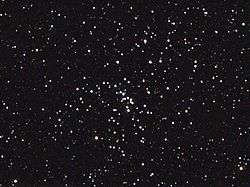Messier 48
Messier 48 or M48, also known as NGC 2548, is an open cluster of stars in the constellation of Hydra. It was discovered by Charles Messier in 1771. There is no cluster in the position indicated by Messier. The value that he gave for the right ascension matches that of NGC 2548, however, his declination is off by five degrees.[6] Credit for discovery is sometimes given instead to Caroline Herschel in 1783.[6] Her nephew John Herschel described it as, "a superb cluster which fills the whole field; stars of 9th and 10th to the 13th magnitude – and none below, but the whole ground of the sky on which it stands is singularly dotted over with infinitely minute points". The brightest component is HIP 40348 at visual magnitude 8.3.[7]
| Messier 48 | |
|---|---|
 | |
| Observation data (J2000 epoch) | |
| Constellation | Hydra |
| Right ascension | 08h 13m 43.0s[1] |
| Declination | −05° 45′ 00″[1] |
| Distance | 2,500 ly (770 pc)[1] |
| Apparent magnitude (V) | 5.8[2] |
| Apparent dimensions (V) | 30′[2] |
| Physical characteristics | |
| Mass | 2,366+1,109 −755[3] M☉ |
| Radius | 63 ly[3] |
| Estimated age | 450±50 Myr[4] |
| Other designations | M48, NGC 2548,[5] Cr 179, H IV-22 |
M48 is visible to the naked eye under good atmospheric conditions. It is located some 2,500 light-years from the Sun.[1] The age estimated from isochrones is 400±100 Myr, while gyrochronology age estimate is 450±50 Myr – in good agreement.[4] The cluster has a tidal radius of 63.3 ± 7.8 ly (19.4 ± 2.4 pc)[3] with at least 438[8] members and a mass of 2,366 M☉.[3] The general structure of the cluster is fragmented and lumpy, which may be due to interactions with the galactic disk. The cluster is now subdivided into three groups, each of which has its own collective proper motion.[8]
References
- Wu, Zhen-Yu; et al. (November 2009), "The orbits of open clusters in the Galaxy", Monthly Notices of the Royal Astronomical Society, 399 (4): 2146–2164, arXiv:0909.3737, Bibcode:2009MNRAS.399.2146W, doi:10.1111/j.1365-2966.2009.15416.x.
- Mullaney, James (2007), The Herschel Objects and How to Observe Them, Astronomers' Observing Guides, Springer Science & Business Media, p. 93, Bibcode:2007hoho.book.....M, ISBN 978-0387681252.
- Piskunov, A. E.; et al. (January 2008), "Tidal radii and masses of open clusters", Astronomy and Astrophysics, 477 (1): 165–172, Bibcode:2008A&A...477..165P, doi:10.1051/0004-6361:20078525.
- Barnes, Sydney A.; et al. (November 2015), "A color-period diagram for the open cluster M 48 (NGC 2548), and its rotational age", Astronomy & Astrophysics, 583: 21, arXiv:1511.00554, Bibcode:2015A&A...583A..73B, doi:10.1051/0004-6361/201526129, A73.
- "M 48". SIMBAD. Centre de données astronomiques de Strasbourg. Retrieved 26 November 2018.
- Houston, Walter Scott (2005), Deep-Sky Wonders, Sky Publishing Corporation, ISBN 978-1-931559-23-2.
- Adam, Len (2018), Imaging the Messier Objects Remotely from Your Laptop, The Patrick Moore Practical Astronomy Series, Springer, p. 227, Bibcode:2018imor.book.....A, ISBN 978-3319653853.
- Vicente, Belén; et al. (September 2016), "NGC 2548: clumpy spatial and kinematic structure in an intermediate-age Galactic cluster", Monthly Notices of the Royal Astronomical Society, 461 (3): 2519–2526, arXiv:1606.06044, Bibcode:2016MNRAS.461.2519V, doi:10.1093/mnras/stw1487.
External links
| Wikimedia Commons has media related to Messier 48. |
- Messier 48, SEDS Messier pages
- Messier 48 on WikiSky: DSS2, SDSS, GALEX, IRAS, Hydrogen α, X-Ray, Astrophoto, Sky Map, Articles and images
